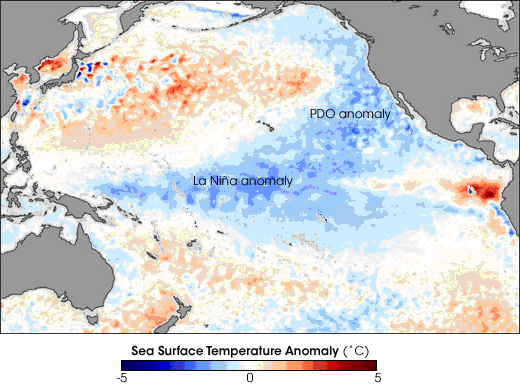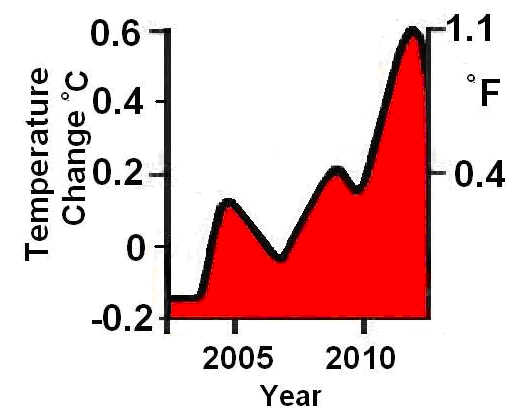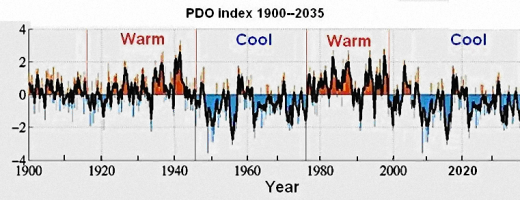A encouraging response on satellite CO2 measurement from the AIRS Team
31 07 2008Recently we’ve been discussing products from the AIRS satellite instrument (Atmospheric InfraRed Sounder) onboard the Aqua satellite. There has been quite a bit of interest in this because unlike the satellite temperature record that goes back to 1979, until now we have not had a complementary satellite derived CO2 record. We are about to have one, and much more.

Click image to see a slide show with this graphic in it (PDF)
I wrote to the AIRS team to inquire about when the satellite data on CO2, and other relevant products might be made public. All that has been released so far are occasional snippets of data and imagery, such as the short slide show above.
Here is the response I got from them:
Thank you for your interest in the AIRS CO2 data product.
We are still in the validation phase in developing this new product.
It will be part of the Version 6 data release, but for now those of us
working on it are intensively validating our results using in situ
measurements by aircraft and upward looking fourier transform IR
spectrometers (TCCON network and others).The AIRS CO2 product is for the mid-troposphere. For quite some time
it was accepted theory that CO2 in the free troposphere is
“well-mixed”, i.e., the difference that might be seen at that altitude
would be a fraction of a part per million (ppmv). Models, which
ingest surface fluxes from known sources, have long predicted a smooth
(small)variation with latitude, with steadily diminishing CO2 as you
move farther South. We have a “two-planet” planet - land in the
Northern Hemisphere and ocean in the Southern Hemisphere. Synoptic
weather in the NH can be seen to control the distribution of CO2 in
the free troposphere. The SH large-scale action is mostly zonal.Since our results are at variance with what is commonly accepted by he
scientific community, we must work especially hard to validate them.
We have just had a paper accepted by Geophysical Research Letters that
will be published in 6-8 weeks, and are preparing a validation paper.We have global CO2 retrievals (day and night, over ocean and land, for
clear and cloudy scenes) spanning the time period from Sept 2002 to
the present. Those data will be released as we satisfactorily
validate them.I suggest you Google “Carbon Tracker” for some interesting maps
generated using model atmospheres and data for CO2 sources. It shows
the CO2 weather in the lowest part of the atmosphere.The big picture is that CO2 sources and sinks are in the planetary
boundary layer. Global circulation of CO2 occurs in the free
troposphere. Thus, PBL is local whereas free troposphere is
international.———-
AIRS Team
With the suggestion of using the Google “Carbon tracker”, some readers might look at this response as a “dodge”. I don’t see it that way at all. Why? Because they are actively engaged in proving the instrument by doing a series of aircraft based measurements to validate the data the instrument on the spacecraft is seeing.
For example, read this paper from them:
First Satellite Remote Sounding of the Global Mid-Tropospheric CO2
These graphics show how hard they are working to validate the data from in situ measurements using airborne flask samples sent to a lab spectrometer: Read the rest of this entry »
Comments : 23 Comments »
Categories : Science, climate_change
Polar Ice Check - Still a lot of ice up there
30 07 2008During our last check in, we had a look at northern Canada from the Arctic Circle to the North pole, and found we had quite a ways to go before we see an “ice free arctic” this year as some have speculated.
Today I did a check of the NASA rapidfire site for TERRA/MODIS satellite images and grabbed a view showing northern Greenland all the way to the North Pole.
There’s some bergy bits on the northeastern shore of Greenland, but in the cloud free area extending all the way to the pole, it appears to still be solid ice.
Click for a larger image - Note: image has been rotated 90° clockwise and sat view sector icon and time stamp added, along with “N” for north pole marker.
Link to original source image is here:
http://rapidfire.sci.gsfc.nasa.gov/realtime/single.php?T082121805
With more than half of the summer melt season gone, it looks like an uphill battle for an ice-free arctic this year.
Here is another view from today from the Aqua satellite:

Click for a larger image - Note: image has been rotated 90° counter- clockwise and sat view sector icon and time stamp added, along with “N” for north pole marker.
Source image is here:
http://rapidfire.sci.gsfc.nasa.gov/realtime/single.php?A082121655
This dovetails with a press release and news story about more ice than normal in the Barents Sea
From the Barents Observer: Read the rest of this entry »
Comments : 101 Comments »
Categories : Science, climate_change
Putting on AIRS
29 07 2008In my digging I discovered that the Apache webserver had open directory listings for folders, and this allowed me to explore a bit to see what I could find. in the \images folder I found a few images that I did not see published on the AIRS website. I’ve saved them to my server should they go offline, but have provided links to the original source URL.
One for Sea Surface Temperature at the tropics seems interesting, though the data period is too short to be meaningful. Note that to eliminate cloud issues, the soundings are done when the satellite has a lookdown to “clear sky”.
I find it interesting that there is a slight global cooling of the oceans during this period of September 2002 to August 2004. The question is: where is the rest of the data and why has the AIRS group not been presenting it on their website? It is after all a publicly funded NASA program.
It is also interesting that this goes against one of the “signatures” of an AGW driven warming. Dr. David Evans writes in this essay: Read the rest of this entry »












